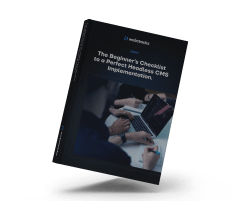With search engines constantly updating their algorithms, staying ahead is crucial. An on-page SEO audit helps ensure your site not only attracts visitors but keeps them engaged—key for hitting performance targets like organic traffic and conversions.
What Should You Look for in an On-Page SEO Audit on Enterprise Websites?
An effective on-page SEO audit covers several key elements to ensure your site performs well in search results and provides a good user experience.
Ensure Content Quality and Relevance
Your content needs to be high-quality, relevant to your audience and well-optimized. This means it should provide value, answer user queries, and include relevant keywords naturally. Regularly updating and refreshing content keeps it relevant and engaging.
Target the Right Keywords
Each page should target a unique primary keyword to avoid keyword cannibalization, where multiple pages compete for the same keyword. This can dilute your SEO efforts and confuse search engines about which page to rank. Programmatic SEO can be part of an advanced on-page SEO strategy, focusing on targeting high-intent keywords effectively.
Optimize the URL Structure
Your URLs should be clean, descriptive, and include target keywords. Avoid using long, complex URLs with unnecessary parameters. A well-structured URL helps search engines understand the content of the page and improves click-through rates.
Write Effective Title Tags and Meta Descriptions
Title tags and meta descriptions are vital for on-page SEO. They should be unique, include target keywords, and stay within the recommended length. These elements help search engines understand the page content and influence click-through rates from search results.
Use Heading Tags Correctly
Proper use of heading tags (H1, H2, H3, etc.) helps organize your content and makes it easier for users and search engines to understand. The H1 tag should include the primary keyword and clearly describe the page's main topic. Subheadings (H2, H3) should break down the content into manageable sections.
Solidify Internal Linking and Site Architecture
Internal links help distribute link equity throughout your site and guide users to related content. A logical site architecture with a clear hierarchy makes it easier for search engines to crawl and index your pages. Ensure important pages are easily accessible from the homepage.
Optimize Your Images
Optimizing images involves compressing them to reduce load times and using descriptive file names. Alt text should describe the image content and include relevant keywords. This helps with accessibility and provides additional context to search engines.
Improve Page Speed and Core Web Vitals
Page speed is a significant ranking factor. Use tools to test your site's load times and identify areas for improvement. Core Web Vitals measure user experience aspects like loading performance, interactivity, and visual stability. Improving these metrics can enhance user satisfaction and search rankings. For a comprehensive approach, consider building a scalable website.

How to Conduct an On-Page SEO Audit
Start by crawling your website using tools like Screaming Frog or Sitebulb. These tools will scan your site and highlight on-page issues such as broken links, duplicate content, and missing meta tags. This gives you a comprehensive overview of what needs fixing.
How Do You Analyze Your Content?
Evaluate the quality, depth, freshness, and optimization of your content. High-quality content should be informative, engaging, and relevant to your audience. Check for thin content that lacks depth or value, duplicate content that can confuse search engines and outdated content that no longer serves its purpose.
Refresh or remove content as needed to keep your site current and valuable. Efficient content workflows ensure regular content updates, which enhance on-page SEO by maintaining content quality and relevance.
Are You Targeting Keywords Effectively?
Ensure each page targets a unique primary keyword to avoid keyword cannibalization, where multiple pages compete for the same keyword.
Use keyword research tools to identify the best keywords for each page. Check if your content aligns with these keywords and make adjustments to improve relevance and ranking potential.
Have You Optimized Your HTML?
Audit your title tags, meta descriptions, header tags, and alt text. Title tags should be concise, and descriptive, and include your primary keyword. Meta descriptions should summarize the page content and entice users to click.
Header tags (H1, H2, etc.) should structure your content logically, making it easier for users and search engines to understand. Alt text for images should describe the image content and include relevant keywords to improve accessibility and SEO. Don't overlook technical SEO optimizations, which are critical for an effective audit.
Is Your Site Architecture User-Friendly?
Review your URL structure, navigation, and internal linking. URLs should be clean, descriptive, and include target keywords. Ensure your site navigation is intuitive, allowing users to find information easily. Internal linking helps distribute link equity throughout your site and guides users to related content. A logical site hierarchy improves crawlability and user experience.
Are Your Page Experience Metrics Optimal?
Test your page speed and Core Web Vitals using tools like Google PageSpeed Insights. Page speed affects user satisfaction and search rankings. Core Web Vitals measure loading performance, interactivity, and visual stability. Identify areas where you can improve load times and user experience, such as optimizing images, reducing server response times, and minimizing JavaScript. Tracking website metrics is crucial for evaluating the effectiveness of page experience metrics.

Is an On-Page SEO Audit Worth It?
Absolutely. On-page SEO forms the backbone of any effective SEO strategy. With search engines continually updating their algorithms and increasing quality standards, conducting regular on-page SEO audits is necessary for maintaining and enhancing your organic search presence in 2024 and beyond.
Ready to elevate your website's performance and user experience? See the Webstacks Difference: Schedule a Brief Discovery Call Today. Let us help you build a scalable, beautiful, and cutting-edge website that drives growth and agility.




